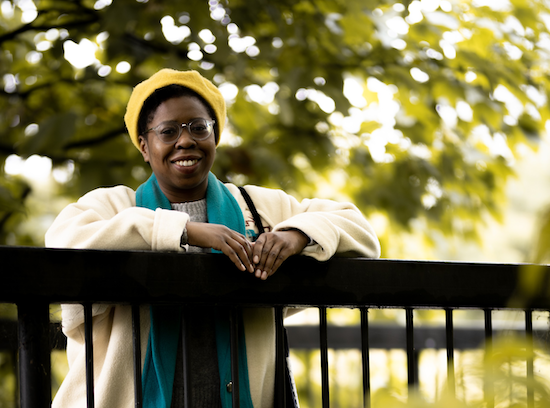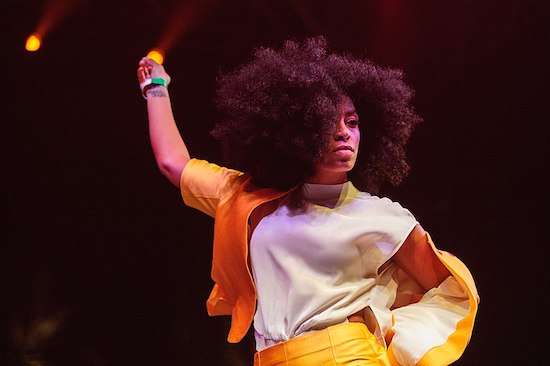Solange performing at Coachella on April 19, 2014. Photo by NeonTommy CC BY-SA2.0
The whiteness of indie rock matters because the participants’ poor understanding of race and unexamined privilege had a lasting effect on Solange, and it all started back in August 2009 at a free Grizzly Bear show in Williamsburg, New York. At the gig, onlookers tried to focus on the cerebral indie act but couldn’t keep their eyes on the stage. As they swayed to the band’s haunting rhythms, to the side of the stage stood Solange, Beyoncé, and Jay-Z. The blogosphere could barely process the moment; Solange brought pop music royalty to a free show in Williamsburg. Overnight, Solange became one of the most powerful influencers of the era. Speaking to Fuse the day after the show, Jay-Z said of Grizzly Bear: “They were just destroying things and I was like this is it. This is what’s gonna happen … The indie rock scene right now is in a great place. I enjoy watching it now more than hip-hop.” Beyoncé began to seek out more high-profile indie artists, collaborating with Patrick Wimberly and Caroline Polachek (aka indie pop act Chairlift), the singer-songwriter James Blake, and Ezra Koenig from the yacht rock–influenced band Vampire Weekend.
News quickly reached the London punk scene, in which I had recently made my home, and no one was more excited about Beyoncé interacting with indie rock than the punks. Friends would run up to me, barely containing their delusional elation that perhaps Beyoncé would make an indie song. The excitable white punks were clutching at nonexistent straws, but so were many other white people in the indie rock scene, who seemed to be desperately on the hunt for the archetypal Black soul diva whose naturally soulful words could sooth a litany of woes. It reminded me of the Black best friend trope in film—you know, the one devoted to the white star, but who is strangely never focused on their own problems. White scenesters wanted to experience Blackness vicariously, using Black artists as positivity cheerleaders to boost them in their lowest moments. In 2019, Lizzo’s positive messaging and soulful bops led to success, but also to confusing accusations that she was making music for white people. Though Lizzo is an artist that a certain brand of white feminist has latched on to (even Mean Girls creator Tina Fey has shown her love for Lizzo’s memeable flute-twerking skills), she has made it clear that no matter who is in her audience, her music is made for a particular ear. “I’m making music that hopefully makes other people feel good and helps me discover self-love. That message I want to go directly to black women, big black women, black trans women. Period.” It seems the indie world is always ready for a new Black soul diva to leach from. Back in 2009, it looked like Beyoncé might play that role, but she had the power to bring the indie world to her, so Solange quickly became the replacement. As a result, she experienced the same microaggressions, barely concealed racism, and ignorant remarks as other Black people in the punk and indie rock scene, including me.
In 2009, I volunteered at the community music festival Ladyfest, a punk initiative that promotes women in music and was kick-started by Allison Wolfe, vocalist in the ’90s riot grrrl band Bratmobile. After years spent searching for other punks, I saw the London scene as my savior. I threw myself into this new world, organizing events, documenting everything on my music blog, and playing in my first band (a feminist punk five-piece called My Therapist Says Hot Damn), formed when I was twenty-two. At first, I felt at home. The scene’s feminist stance aligned with my own nascent political identity, and the people I met welcomed me into their world like an old friend. Despite being on point with queer politics and feminist issues, there was a blindingly obvious problem: the scene was predominantly white, and no one talked about it.
I was one of a handful of people of color in the London punk scene at the time. I would occasionally see Rachel Aggs (the prolific guitarist and singer known for her work in post-punk bands Sacred Paws, Shopping, and Trash Kit) at gigs, but we rarely spoke. Instead we did the same awkward dance around acknowledging each other’s presence that so many other people of color engage in daily in majority white spaces. The feeling was that you couldn’t possibly draw too much attention to yourself or that your Blackness was ever present. So I and others hid ourselves to stay part of a community that was, at least partially, home. Seeing friends utter racist statements or engage in cultural appropriation was brutal. It was confusing to feel so close to people who had no capacity to relate to such an important part of myself. At practically every punk club night, DJs would play a selection of hip-hop and r&b classics that were old enough to be considered vintage (usually only a decade old) and therefore cool enough for the majority white crowd, who would flood the dance floor, kicking and stomping off-beat. In the middle of those dance floors, I could see the smirks on their faces, the mimicking of dance moves popularized by Black people. They were mocking Black people and using Black culture as their personal costume; it hurt.

Stephanie Phillips
During this period, indie rock artists who incorporated traditionally Black genres into their sound began to gain popularity. Though the indie rock world referenced r&b, it was often in an appropriative way, taking elements of the sound while regarding r&b as a genre that did not match the supposed integrity of indie. This pick-and-mix attitude toward other cultures allowed for the majority white, and often middle-class, group of musicians to make a surface-level nod to multiculturalism without unpicking their own privileges. They could reference everything from West African highlife to Afro-Portuguese music in their genre-bounding escapades and be perceived as worldly and mysterious. One could argue that their ability to lift references without fear is due to middle-class economic freedom or the high cultural literacy that can come when you are exposed to wider culture at an early age. In reality, it is simply because white privilege grants itself entry into every room and every space.
Despite the popularity of the indie rock appropriators a decade ago, they rarely sounded as soulful as the artists they were imitating. Enter Solange, who appeared on the landscape with an effortless cover of one of the hottest songs of the year, from Brooklyn’s Dirty Projectors, who themselves excelled in their Aaliyah-influenced r&b filtered through quirky pop output. It didn’t take much to turn Dirty Projectors’ ‘Stillness Is the Move’ into an r&b classic. It basically already was one. The stuttering lead guitar line that composes the main repetitious riff would sound at home anywhere in the illustrious r&b producer Timbaland’s lengthy back catalog. Further, lead singer Amber Coffman’s syrupy vocals contained the same soft vocal runs and breathy falsetto as Aaliyah in her prime. By sliding in a sample of the guitar lick from ‘Bumpy’s Lament’ by Soul Mann and the Brothers – famously sampled by both neo-soul legend Erykah Badu on ‘Bag Lady’ and rapper Dr Dre on ‘Xxplosive’ – Solange took the song to the level it was meant to be heard at. I already loved the lopsided original version, but hearing Solange’s angelic vocal interacting with the historic sample felt like she brought ‘Stillness Is the Move’ back home to the Black community that inspired its creation. She received rave reviews from Village Voice, and one of the gatekeepers of alternative music at the time, Pitchfork. Though the Pitchfork reviewer Zach Kelly longed for the other Knowles to tackle this weighty cover (reflecting the indie scene’s obsession with seeing Solange as Beyoncé), he did rate the song, stating: “It’s a brilliantly sly take on a great song that reflects the malleability of Dirty Projectors’ music as well as Solange’s impeccable taste.” This sign-off from one of the most influential music outlets in the industry forced people to take notice of the woman who was saying, loud and clear to those paying attention, this music right here is mine for the taking, too.
Why Solange Matters by Stephanie Philips is published by Faber


